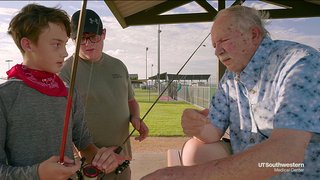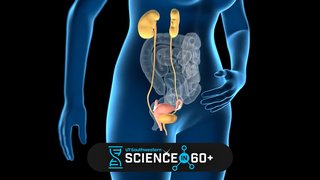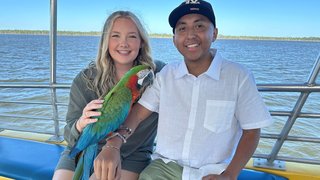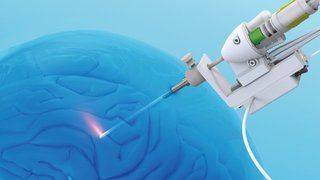Special de-liver-y transplant: Aunt donates portion of liver to save young adult niece
November 20, 2024
Anyone watching Kelly Rowe set records as a sprinter at Mansfield Lake Ridge High School, and then compete on a track scholarship at the University of Mississippi, would assume she was in peak health. They’d have no reason to suspect she had been on a battery of medications and gone to countless doctor appointments ever since she was 8. That’s when she was diagnosed with autoimmune hepatitis, a condition that attacks the liver and leads to long-term damage.
By the time Kelly was 21 in her final semester at Ole Miss, the list of diseases she had endured for years included cirrhosis (scarring) of the liver, primary sclerosing cholangitis (PSC), and ulcerative colitis, a form of inflammatory bowel disease (IBD). In spring 2022, doctors at UT Southwestern Medical Center, and earlier at Children’s Medical Center Dallas, began discussing “the T-word.”
When the Rowes learned that Kelly was a strong candidate for UTSW’s Living-Donor Liver Transplantation Program, volunteers quickly stepped up.

Her mother, Lynell, was the first to offer part of her liver – the liver has a remarkable capacity to regenerate within weeks, which makes living-donor transplantation possible. She wasn’t a match, but when Kelly’s father, Keith, asked his only sister, Catinna “Tina” Mallett, if she’d be willing, she said yes without hesitation because her brother’s kids “are like my children – just like an extension of me.”
Aunt Tina was an ideal match – she and Kelly have O positive blood and similar heights, weights, and body types, and Catinna was in overall good health.
On June 14, 2023, one team led by Madhukar Patel, M.D., Surgical Director of UT Southwestern’s Living-Donor Liver Transplantation Program, removed 65% of Catinna’s healthy liver at William P. Clements Jr. University Hospital.

A second team led by Parsia Vagefi, M.D., Chief of Surgical Transplantation, removed Kelly’s chronically damaged liver and replaced it with Catinna’s donated organ. Both complex procedures went seamlessly, lasting four-and-a-half hours. Kelly spent eight days in the hospital; Catinna went home to Cedar Hill a couple of days sooner.
Over a year later, the 24-year-old niece and her 52-year-old aunt are in great health – and exceedingly thankful.
“I’m just grateful I had my aunt to give me a transplant and I wasn’t on the list so long, because there are a lot of people who never have the opportunity to get one,” says Kelly, who lives in Waxahachie with her parents. “I thank God every day I’m here to tell my story, and hopefully people who are going through the same thing know they can make it through and they’re not alone.”
For her aunt, a focus on family, love, and faith made the decision to give her “Niecey-poo” a piece of herself automatic.
“The fact that I had the honor and the privilege to do this for my niece – surreal’s a good word,” says Cattina, a local oncology nurse. “I would do it all over again. I’m thankful every day that I was a fit and could do this for her. Of course I’m a nurse, so I’m always about trying to help somebody and save a life anywhere I can.”
‘Doing all the things a 24-year-old should’

Mark Pedersen, M.D., Assistant Professor of Internal Medicine and Medical Director of UTSW’s Living-Donor Liver Transplantation Program, screens organ donor candidates (as he did Catinna), then treats the recipient and donor after transplant. Considering all that Kelly has been through since she was a child, she’s “doing exceptionally well,” he says.
“I could quote a bunch of numbers from her labs and tell you they all look fantastic and her liver’s functioning very well, and it is,” Dr. Pedersen says. “But to me, the biggest proof is how well she’s doing, living her life, and doing all the things a 24-year-old should be doing.”
To help determine whether patients need a transplant, clinicians calculate a Model for End-Stage Liver Disease (MELD) score based on the results of several blood tests including bilirubin, albumin, and creatinine.

MELD ranks disease severity on a scale of 6-40, with higher scores indicating a lower likelihood of patient survival within three months.
Transplant hepatologist Arjmand Mufti, Associate Professor of Internal Medicine, Medical Director of the Liver Transplantation Program, and Founding Medical Director of the Living-Donor Liver Transplantation Program, took part in Catinna’s donor evaluation and has seen Kelly as a patient. He says Kelly’s MELD score reached 18 – a number, Dr. Pedersen says, equating to “maybe a 6% to 10% chance of dying with her liver at three months.”
But, Dr. Mufti added, MELD scores can be misleading. And for Kelly, the living-donor route was “the most expeditious and safest manner to get her to transplant,” he says.
“Especially in conditions like Kelly’s, the MELD score may not actually reflect how sick you are,” Dr. Mufti says.

“The danger is that you’re going to get sicker and your MELD score marches up, and by the time you get an organ, you might be too sick for transplant. This case is almost the prototype of what we’re looking for with living donation – and it worked perfectly for Kelly because when she got to transplant, she was actually quite sick.”
Now, Kelly gets weekly blood tests and sees Dr. Pedersen every three months. She’s on an immunosuppressant and other meds including prednisone, which she has taken since her childhood diagnosis.
Catinna, who, like Kelly, has benefited from the liver’s remarkable capacity to regenerate to virtually full size, says her appetite and energy were low the first months after the procedure. But she’s doing well now and will see Dr. Pedersen again next year for an annual checkup.
Living-donor liver program’s genesis
Amid a nationwide shortage of livers from deceased donors, almost 9,400 patients in the U.S. were awaiting a liver transplant as of Nov. 20, 2024. During 2023, 10,659 liver transplants were performed in the U.S., but 1,946 patients were removed from the waitlist because they became too sick or died.
UTSW's liver transplant program started in 2007, and 114 of the procedures were performed in 2023, making it No. 1 in North Texas for the fifth consecutive year. The living-donor liver program took off about a year and a half after its late-2019 inception, Dr. Vagefi says, and has since contributed to the lifesaving legacy of UTSW’s overall transplant program.
“We’ve had excellent results and have been able to help a lot of people who otherwise wouldn’t have been able to achieve transplant,” says Dr. Vagefi, Professor and Executive Vice Chair of Strategy and Finance in the Department of Surgery.
Many patients in need of transplants don’t know how to seek out a living donor and are reluctant to make such a request, Dr. Patel says. UTSW provides organ recipients access to a “champion” who focuses on helping them through the donor search and transplant process.
“If you talk to donors, they have no regrets,” Dr. Patel says. “They would love for other people to learn about it because, psychologically, it’s had such a positive impact on their lives.”
Related reading: 5 tips to find a living kidney or liver donor
'My doctors became my family'

As a little girl, Kelly Rowe lived in Havelock, N.C., with her two older brothers and their parents, who were stationed at Marine Corps Air Station Cherry Point. When Kelly was 4 years old, her mother noticed her daughter’s eyes looked yellowed and jaundiced so she took her to base doctors, who concluded nothing was wrong.
In 2008, when Kelly was 8 and the Rowes moved to Mansfield, her parents brought her to a pediatrician who recommended she see a liver specialist. That was when she received her autoimmune hepatitis diagnosis, which took a psychological toll in addition to other physical symptoms.
“I felt out of place, like I was weird because I would always have to leave school and couldn’t really do everything my friends were doing,” Kelly says. “I didn’t want people to feel bad for me. Thankfully I had people around me who kept encouraging me, and as time went on, I got used to going to the doctors and actually enjoyed it. Basically, my doctors became my family.”

As Kelly grew up, she was treated for colitis and PSC, which causes scarring in the bile ducts that leads to liver damage. After she decided to pursue track, there were times she considered giving it up, but her doctor encouraged her to keep going to stay healthy and fit. Kelly graduated from high school in 2018 after helping her team win a state track title, then moved to Oxford, Miss., for college and more competitive track.
At age 20 in 2021, Kelly became a patient of Marlyn Mayo, M.D., Professor of Internal Medicine in UTSW’s Division of Digestive and Liver Diseases, who specializes in the diagnosis and treatment of acute and chronic liver diseases. The two quickly formed a close bond.
“I remember being so impressed with this young lady that she had all these severe chronic diseases but was still going through college with gusto and competing on the track team,” Dr. Mayo says. “I knew on that first day that she was tough, and she was a survivor, and I wanted to do whatever I could to help her."
Starting grad school with a transplant on horizon

After Kelly graduated from Ole Miss in spring 2022, she enrolled in online graduate studies at the Texas A&M School of Law. She juggled that load with the emotional uncertainty of an impending liver transplant, while her aunt started donor testing that fall to ensure she checked all the compatibility boxes.
Before she was set to start grad school, Kelly had developed jaundice and a liver biopsy showed more cirrhotic scarring, so Dr. Mayo referred her for transplant evaluation to gastroenterologist/ transplant hepatologist Shannan Tujios, M.D., Associate Professor of Internal Medicine in the Division of Digestive and Liver Diseases. Kelly stayed under Dr. Tujios’ care until three months post-transplant, when she transitioned to Dr. Pedersen.
“When I first met Kelly, I was struck by how mature, positive, and forward thinking she is,” Dr. Tujios says. “She is a dynamo and did not let her illness get her down, and if you did not have her medical chart in front of you, you would never know the illnesses she’s had to manage and overcome. She embodies quiet determination.”
Dr. Tujios also was impressed at how close-knit and supportive Kelly’s family was, with her parents attending every appointment to support and advocate while giving her autonomy. “It’s challenging to be the parent/caregiver of someone going through something like organ transplant,” Dr. Tujios says, “but to also have the fortitude to trust the patient’s wishes and their medical team speaks volumes about their strength and closeness as a family.”

As transplant day arrived on June 14, 2023 – exactly one month before Kelly’s 23rd birthday – she felt no butterflies.
“When we got to the hospital, my mom looked scared and I said, ‘Mom, I’ll be fine,’” Kelly says. “I’m really honestly never nervous because I know that God has me, and I’ll be fine. I remember our pastor came with his wife and prayed over me before I went back.”
The personalized, professional care made the entire transplant process smooth, Catinna and Kelly say.
“They were very attentive, very responsive,” says Catinna, who has a 10-year-old son with her husband, Jerold, and two adult children from a previous relationship. “Even the surgeon (Dr. Patel) gave me his cellphone number. He was like, ‘Anytime you need me, just call.’ And I would message him pretty regularly after the surgery and he was always responsive. I was very impressed. It was just great from start to finish.”
Just a couple of months after her transplant, Kelly resumed graduate studies. In May 2024, as she was about to receive her Master of Legal Studies with an emphasis in Cybersecurity Law and Policy, she spent a week in the hospital after experiencing a mild rejection of her new liver. According to Dr. Pedersen, about 20% of liver transplant patients experience organ rejection issues, but Kelly’s were caught early thanks to UTSW’s monitoring protocols. Liver transplant rejection is treatable with adjustment of immunosuppressants, and no adverse effects are expected thereafter.
Kelly left the hospital on a Friday evening, and the following day, her family was cheering her on during Texas A&M graduation at the Mansfield ISD Center for the Performing Arts.
Related reading: Son gives ‘most meaningful gift’ to father and stepfather
Celebrating their first ‘liverversary’
A year to the day after their transplant, family and friends joined Kelly and her aunt at an Italian restaurant to celebrate their “liverversary.” During the event, organized by Kelly’s mother and planned as an annual tradition, Kelly, her parents, and Catinna gave moving speeches about what the gift of life has meant to them.

In addition, Kelly’s mom created cards with a QR code through which donations could be made to the Living-Donor Liver Transplantation Program in Kelly’s honor. The family raised over $200 during the month leading up to Kelly’s 24th birthday and says anyone can still donate.
“My niece is sitting here with me, and we get to celebrate many more years together,” Catinna says. “We’re thankful to UT Southwestern for the opportunity. First and foremost, we’re thankful to God that he presented it to us, and it was able to happen. We love our family, we love our friends, and all those who supported us in this.”
And for the clinicians who helped this transplant journey unfold in a way that leaves everyone feeling fortunate – and relieved – there’s a deep sense of gratification.
“You get to see somebody who’s getting sicker and sicker all of a sudden start getting better day by day,” Dr. Pedersen says. “It takes a lot of hard work from a lot of people, but that’s the incredible thing about transplant and expanding the access of transplant to more and more people through living donors. We are so happy for them, and it is incredibly rewarding to see them doing so well.”
For more information about UT Southwestern's transplant program and how to sign up to be an organ donor with Donate Life or through your local Department of Motor Vehicles (DMV), please visit our transplant website.










